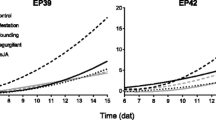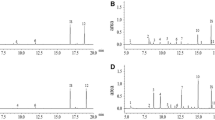Abstract
Large-scale implementation of transgenic crop varieties raises concerns about possible nontarget effects on other organisms. This study examines the effects of genetic modification on plant volatile production and its potential impact on arthropod population dynamics. We compared herbivore-induced volatile emissions from Bacillus thuringiensis Berliner (Bt) maize plants to those from a nontransformed isoline following exposure to various types of leaf damage. When equal numbers of Helicoverpa zea Boddie (Lepidoptera: Noctuidae) larvae fed on Bt and non-Bt maize, volatile emissions were significantly lower in the transgenic plants, which also exhibited less leaf damage. When damage levels were controlled by adding more larvae to Bt plants, the plants' volatile emissions increased but displayed significant differences from those of nontransgenic plants. Significantly higher amounts of linalool, β-myrcene, and geranyl acetate were released from transgenic maize than from non-Bt plants. Manipulating the duration of feeding by individual larvae to produce similar damage patterns resulted in similar volatile profiles for Bt and non-Bt plants. Controlling damage levels more precisely by mechanically wounding leaves and applying larval regurgitant likewise resulted in similar emission patterns for Bt and non-Bt maize. Overall, changes in the herbivore-induced volatile profiles of Bt maize appeared to be a consequence of altered larval feeding behavior rather than of changes in biochemical plant defense pathways. The implications of these findings for understanding the impacts of plant-mediated cues on pest and natural enemy behavior in transgenic crop systems are discussed.


Similar content being viewed by others
References
Anderson, P. and Alborn, H. 1999. Effects on oviposition behaviour and larval development of Spodoptera littoralis by herbivore-induced changes in cotton plants. Entomol. Exp. Appl. 92:45–51.
Ashfaq, M., Young, S. Y., and McNew, R. W. 2001. Bollworm (Lepidoptera: Noctuidae) development and movement on Bacillus thuringiensis-treated cotton leaves. J. Entomol. Sci. 36:23–33.
Capinera, J. 2000. Featured Creatures: Corn earworm. University of Florida, Report no. EENY-145.
De Moraes, C. M., Lewis, W. J., Pare, P. W., Alborn, H. T., and Tumlinson, J. H. 1998. Herbivore-infested plants selectively attract parasitoids. Nature 393:570–573.
De Moraes, C. M., Mescher, M. C., and Tumlinson, J. H. 2001. Caterpillar-induced nocturnal plant volatiles repel nonspecific females. Nature 410:577–580.
De Moraes, C.M. and Mescher, M.C. 2004. Biochemical crypsis in the avoidance of natural enemies by an insect herbivores. Proc. Natl. Acad. Sci. USA 101:8993–8997.
Dicke, M., Vanbeek, T. A., Posthumus, M. A., Bendom, N., Vanbokhoven, H., and Degroot A. E. 1990. Isolation and identification of volatile kairomone that affects acarine predator–prey interactions—Involvement of host plant in its production. J. Chem. Ecol. 16:381–396.
Dicke, M. and Van Loon, J. J. A. 2000. Multitrophic effects of herbivore-induced plant volatiles in an evolutionary context. Entomol. Exp. Appl. 97:237–249.
Gore, J., Leonard, B. R., Church, G. E., and Cook, D. R. 2002. Behavior of bollworm (Lepidoptera: Noctuidae) larvae on genetically engineered cotton. J. Econ. Entomol. 95:763–769.
Gore, J., Adamczyk, J. J., and Blanco, C. A. 2005. Selective feeding of tobacco budworm and bollworm (Lepidoptera: Noctuidae) on meridic diet with different concentrations of Bacillus thuringiensis proteins. J. Econ. Entomol. 98:88–94.
Gouinguene, S., Pickett, J. A., Wadhams, L. J., Birkett, M. A., and Turlings, T. C. J. 2005. Antennal electrophysiological responses of three parasitic wasps to caterpillar-induced volatiles from maize (Zea mays mays), cotton (Gossypium herbaceum), and cowpea (Vigna unguiculata). J. Chem. Ecol. 31:1023–1038.
Gould, F. 1998. Sustainability of transgenic insecticidal cultivars: Integrating pest genetics and ecology. Annu. Rev. Entomol. 43:701–726.
Gould, F., Kennedy, G. G., and Johnson, M. T. 1991. Effects of natural enemies on the rate of herbivore adaptation to resistant host plants. Entomol. Exp. Appl. 58:1–14.
Harmon, J. P., White, J. A., and Andow, D. A. 2003. Oviposition behavior of Ostrinia nubilalis (Lepidoptera: Crambidae) in response to potential intra- and interspecific interactions. Environ. Entomol. 32:334–339.
Hellmich, R. L., Higgins, L. S., Witkowski, J. F., Campbell, J. E., and Lewis, L. C. 1999. Oviposition by European corn borer (Lepidoptera: Crambidae) in response to various transgenic corn events. J. Econ. Entomol. 92:1014–1020.
Liu, Y. B., Tabashnik, B. E., Dennehy, T. J., Carriere, Y., Sims, M. A., and Meyer, S. K. 2002. Oviposition on and mining in bolls of Bt and non-Bt cotton by resistant and susceptible pink bollworm (Lepidoptera: Gelechiidae). J. Econ. Entomol. 95:143–148.
Mori, N., Alborn, H. T., Teal, P. E. A., and Tumlinson, J. H. 2001. Enzymatic decomposition of elicitors of plant volatiles in Heliothis virescens and Helicoverpa zea. J. Insect Physiol. 47:749–757.
National Agricultural Statistics Service. 2005. Acreage. Agricultural Statistics Board, U.S. Department of Agriculture, Report no. Cr Pr 2–5 (6-05).
Pare, P. W., Farag, M. A., Krishnamachari, V., Zhang, H. M., Ryu, C. M., and Kloepper, J. W. 2005. Elicitors and priming agents initiate plant defense responses. Photosynth. Res. 85:149–159.
Rose, U. S. R., Lewis, W. J., and Tumlinson, J. H. 1998. Specificity of systemically released cotton volatiles as attractants for specialist and generalist parasitic wasps. J. Chem. Ecol. 24:303–319.
Saxena, D. and Stotzky, G. 2001. Bt corn has a higher lignin content than non-Bt corn. Am. J. Bot. 88:1704–1706.
Schmelz, E. A., Alborn, H. T., Banchio, E., and Tumlinson, J. H. 2003. Quantitative relationships between induced jasmonic acid levels and volatile emission in Zea mays during Spodoptera exigua herbivory. Planta 216:665–673.
Schuler, T. H., Poppy, G. M., Kerry, B. R., and Denholm, I. 1999a. Potential side effects of insect-resistant transgenic plants on arthropod natural enemies. Trends Biotechnol. 17:210–216.
Schuler, T. H., Potting, R. P. J., Denholm, I., and Poppy, G. M. 1999b. Parasitoid behaviour and Bt plants. Nature 400:825–826.
Shelton, A. M., Zhao, J. Z., and Roush, R. T. 2002. Economic, ecological, food safety, and social consequences of the deployment of Bt transgenic plants. Annu. Rev. Entomol. 47:845–881.
Sked, S. 2003. Host–parasitoid interactions between Macrocentrus cingulum Brischke (Hymenoptera: Braconidae) and its host, Ostrinia nubialis Hubner (Lepidoptera: Crambidae): Implications for ECB management. Master's Thesis. The Pennsylvania State University, University Park.
Smith, R. M., Marshall, J. A., Davey, M. R., Lowe, K. C., and Power, J. B. 1996. Comparison of volatiles and waxes in leaves of genetically engineered tomatoes. Phytochemistry 43:753–758.
Sokal, R. R. and Rohlf, F. J. 1995. Biometry: The Principles and Practice of Statistics in Biological Research. W.F. Freeman and Co., New York.
Turlings, T. C. J. and Tumlinson, J. H. 1992. Systemic release of chemical signals by herbivore-injured corn. Proc. Natl. Acad. Sci. USA 89:8399–8402.
Turlings, T. C. J., Tumlinson, J. H., and Lewis, W. J. 1990. Exploitation of herbivore-induced plant odors by host-seeking parasitic wasps. Science 250:1251–1253.
Turlings, T. C. J., Tumlinson, J. H., Heath, R. R., Proveaux, A. T., and Doolittle, R. E. 1991. Isolation and identification of allelochemicals that attract the larval parasitoid, Cotesia marginiventris (Cresson), to the microhabitat of one of its hosts. J. Chem. Ecol. 17:2235–2251.
Turlings, T. C. J., Lengwiler, U. B., Bernasconi, M. L., and Wechsler, D. 1998. Timing of induced volatile emissions in maize seedlings. Planta 207:146–152.
Wiseman, B. R., Lynch, R. E., Plaisted, D., and Warnick, D. 1999. Evaluation of Bt transgenic sweet corn hybrids for resistance to corn earworm and fall armyworm (Lepidoptera: Noctuidae) using a meridic diet bioassay. J. Entomol. Sci. 34:415–425.
Yan, F., Bengtsson, M., Anderson, P., Ansebo, L., Xu, C., and Witzgall, P. 2004. Antennal response of cotton bollworm (Helicoverpa armigera) to volatiles in transgenic Bt cotton. J. Appl. Entomol. 128:354–357.
Acknowledgments
We thank J. Tooker, M. C. Mescher, J. Tumlinson, C. Frost, C. Delphia, and J. Runyon for helpful comments and J. Saunders, E. Bogus, A. Conrad, K. Cortellini, and M. Peiffer for technical support. This project was supported by the David and Lucile Packard Foundation and the Beckman Foundation. Jennifer Dean is supported under a National Science Foundation Graduate Research Fellowship.
Author information
Authors and Affiliations
Corresponding author
Rights and permissions
About this article
Cite this article
Dean, J.M., De Moraes, C.M. Effects of Genetic Modification on Herbivore-Induced Volatiles from Maize. J Chem Ecol 32, 713–724 (2006). https://doi.org/10.1007/s10886-006-9040-0
Received:
Revised:
Accepted:
Published:
Issue Date:
DOI: https://doi.org/10.1007/s10886-006-9040-0




